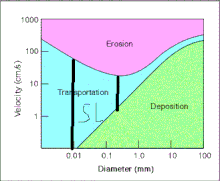The suspended load of a flow of fluid, such as a river, is the portion of its sediment uplifted by the fluid's flow in the process of sediment transportation. It is kept suspended by the fluid's turbulence. The suspended load generally consists of smaller particles, like clay, silt, and fine sands.
YouTube Encyclopedic
-
1/5Views:9991 6737 70451 0236 876
-
Bedload and Suspended Load Transport (sed strat)
-
Modes of Sediment Transport in a River | Bed load | Contact Load | Suspended load | Wash Load
-
Vision-Based Cable-Suspended Load Transport with Two Quadrotors
-
2 - Sediment transport
-
Monitoring suspended sediment for dam removal
Transcription
Sediment transportation

The suspended load is one of the three layers of the fluvial sediment transportation system. The bed load consists of the larger sediment which is transported by saltation, rolling, and dragging on the riverbed. The suspended load is the middle layer that consists of the smaller sediment that's suspended. The wash load is uppermost layer which consist of the smallest sediment that can be seen with the naked eye; however, the wash load gets easily mixed with suspended load during transportation due to the very similar process. The wash load never touches the bed even outside of a current.
Composition
The boundary between bed load and suspended load is not straightforward because whether a particle is in suspension or not depends on the flow velocity – it is easy to imagine a particle moving between bed load, part-suspension and full suspension in a fluid with variable flow. Suspended load generally consists of fine sand, silt and clay size particles although larger particles (coarser sands) may be carried in the lower water column in more intense flows.
Suspended load vs suspended sediment
Suspended load and suspended sediment are very similar, but are not the same. Suspended Sediment contains sediment uplifted in Fluvial zones, but unlike suspended load no turbulence is required to keep it uplifted. Suspended loads required the Velocity to keep the sediment transporting above the bed. With low velocity the sediment will deposit.
Velocity
The suspended load is carried within the lower to middle part of the water column and moves at a large fraction of the mean flow velocity of the stream, with a Rouse number between 0.8 and 1.2. The rates within the Rouse number reveal how at which the sediment will transport at the current velocity. It is the ratio of the fall velocity and uplift velocity on a grain.
| Mode of Transport | Rouse Number |
|---|---|
| Bed Load | >2.5 |
| Suspended Load 50% | >1.2, <2.5 |
| Suspended Load 100% | >0.8, <1.2 |
| Wash Load | <0.8 |
Diagrams

Suspended load is often visualised using two diagrams. The Hjulström curve uses velocity and sediment size to compare the rate of erosion, transportation, and deposition. While the diagram shows the rate, one flaw about the Hjulström Diagram is that it doesn't show the depth of the creek giving an estimated rate.
The second diagram used is the Shields Diagram. The Shields Diagram uses the critical shield stress and Reynolds number to estimate transportation rate. Shields Diagram is considered a more precise chart to estimate suspended load.[1][2]
Measuring suspended load
Shear stress
To find the stream power for sediment transportation, shear stress helps determine the force required to allow sediment transportation.
Critical shear stress
The point at which the sediment is transported within a stream
Suspended load transport rate
See also
References
- ^ Shields, A.. (1936). Anwendung der Aehnlichkeitsmechanik und der Turbulenzforschung auf die Geschiebebewegung [Application of similarity mechanics and turbulence research on shear flow] (PDF). Mitteilungen der Preußischen Versuchsanstalt für Wasserbau (in German). Vol. 26. Berlin: Preußische Versuchsanstalt für Wasserbau. Archived from the original on 2011-07-18.
- ^ Shields, A. (1936). "Application of similarity principles and turbulence research to bed-load movement (translated version)". Caltech Library. Mitteilungen der Preußischen Versuchsanstalt für Wasserbau. Berlin: Preußische Versuchsanstalt für Wasserbau. 26.
Further reading
- "Sediment Transport and Deposition". Fondriest Environmental Learning Center. Fondriest Environmental, Inc. Retrieved 23 March 2019.
- Lemke, Karen A. (12 September 2017). "Stream Sediment". Geography/Geology 312: Geomorphology. University of Wisconsin-Stevens Point. Retrieved 23 March 2019.



![{\displaystyle q{\scriptstyle {\text{s}}}=w.h.c{\scriptstyle {\text{a}}}.[((a/h)^{z}-(a/h))/((1-a/h)Z.(1.2-Z))]}](https://wikimedia.org/api/rest_v1/media/math/render/svg/0d168024e695aa11726366cd5c5e049df9590798)